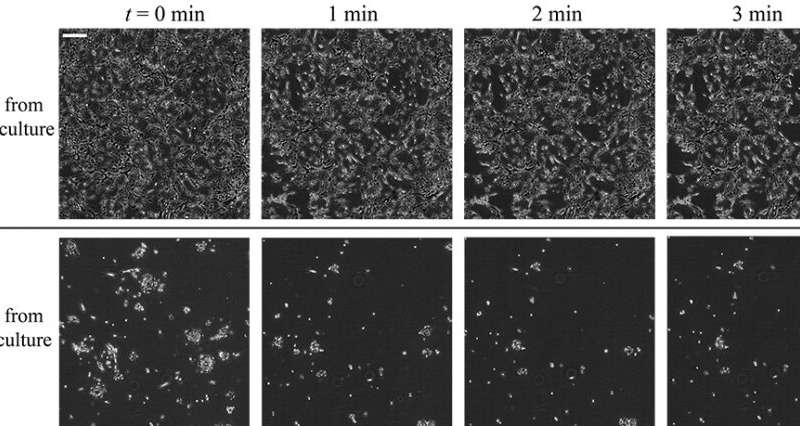
For medical professionals treating hydrocephalus—a chronic neurological condition caused by an abnormal accumulation of cerebrospinal fluid (CSF), resulting in pressure on the brain—there have been a limited range of treatment options. The most common is the surgical placement of a medical device called a shunt, a sort of flexible tube, which is placed in the ventricular system of the brain, diverting the flow of CSF from the brain to elsewhere in the body.
While effective, this surgery comes with risks (the procedure requires drilling a hole into the skull, after all), and the failure rate for these shunts, despite their lifesaving properties, is quite high. Whether congenital (present at birth, including spina bifida) or acquired (from a brain injury, for instance)—hydrocephalus affects more than 1 million Americans, ranging from infants and older children to seniors.
Now, MIT researchers have released a paper in the Journal of the Royal Society Interface that proposes and validates a new design principle for hydrocephalus catheters that seeks to overcome a central challenge in the design of these devices: that they regularly become clogged. A clogged catheter has life-threatening implications, especially for children, and usually leads to emergency surgery, the reopening of sealed scars and the possible need for resection of the implanted catheter from the brain before putting a new catheter in, followed by required additional healing time. This process carries with it the risk of damage to brain tissue and infection. For pediatric patients, catheters have a 60 percent chance of failure, often due to tissue that is clogs the catheters, eventually stopping the flow of CSF away from the brain.
The new research focuses on the potential redesign of the shunts, according to one of the authors of the paper, Thomas Heldt, an associate professor of electrical and biomedical engineering in the Department of Electrical Engineering and Computer Science and the Institute of Medical Engineering and Science (IMES). He points out that an important part of the research process was to conduct in vitro experiments exposing cell cultures to fluid shear stress, in addition to microfluidic flow imaging, and conducting fluid dynamic calculation and measurements.
“The point we are seeking to bring across is how to best design the catheter geometry to optimize the function of this medical device,” says Heldt. “These are design parameters that can change in such a way that a minimum force on the catheter walls is imposed to ensure minimal risk of cells adhesion in the first place.”
Lydia Bourouiba, the senior author of the paper and an associate professor in the departments of Civil and Environmental Engineering, Mechanical Engineering, and IMES, who directs The Fluid Dynamics of Disease Transmission Laboratory, says of the research: “The novelty is that we leveraged the coupling between mechanical (i.e., fluid dynamics here) principles and biological and cell response to enable novel pathways in design principles of these lifesaving medical devices.”
Along with Bourouiba and Heldt, the authors of the paper are Songkwon Lee, a Ph.D. student in the Department of Mechanical Engineering; Nicholas Kwok, an MD student in the Harvard-MIT Program in Health Sciences and Technology; and James Holsapple, chief of neurosurgery at Boston Medical Center.

According to Heldt, the new research could lead to redesigned shunts that would “keep the minimum wall shear stress sufficiently high, above a threshold value we identified to be sufficient to minimize cell adhesion and proliferation. If we prevent these cells from adhering in the first place, we undercut the key step responsible for long-term clogging and failure of brain catheters.”
Dwight Meglan, an engineer who is the chief technology officer of HeartLander Surgical, a medical device company, has a daughter, Emma, who has needed hydrocephalus catheters since birth. He says that due to his own background as an engineer, he has puzzled over how catheters could be more resistant to failure, and has sometimes conferred with Heldt on the challenge. He says that what he finds interesting about the new research, if it leads to a new catheter construction, is that “this is more foundational than some other research I’ve seen, because they are actually looking at this from the point of view that perhaps the problem is due to an underlying design failure.”
Bourouiba says that previously, research on preventing shunt failures has often focused on “surface engineering, with little translation into practice due to the sensitive location in which these catheters are used: the brain. A major concern is the durability and stability of chemical solutions in long-term usage in a patient’s brain, particularly when developing brains are involved.”
By contrast, she continues, “Our paper leveraged a novel combination of state-of-the-art flow visualization and quantification, fluid dynamics modeling, coupled with in-vitro experiments, to arrive at new design principles for these catheters, based on the concept of maximizing the minimal fluid shear stress so as to prevent cells from successfully adhering to and weakly proliferating onto the catheter in the first place.”
Kwok, a fourth-year medical student, said he was looking for a research project for his thesis when Heldt suggested the hydrocephalus catheter research idea, combining “engineering and medicine to develop new diagnostic and therapeutic technologies … and I was hooked.” He says he hopes to pursue basic science research during an internal medicine residency he will apply for in the fall, with the goal of “clinically oriented engineering research as a practicing physician, combining patient care with therapeutic innovation.”
For Edward Smith, the R. Michael Scott Chair in Neurosurgery at Boston Children’s Hospital, the potential for lifesaving advances that could mitigate the frequency of shunt malfunctions is encouraging. “The data presented in this manuscript are novel, and offer a different way of looking at a serious problem routinely faced by clinicians,” he adds.
Source: Read Full Article
